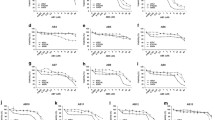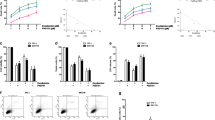Abstract
Purpose
Dysregulation of histone acetylation associated with an up-regulation of histone deacetylase (HDAC) activity is common in malignant tumours. Therefore, HDAC inhibitors were developed whose effects on proliferation and apoptosis have been shown in different tumour entities. Since non-iodide-concentrating thyroid carcinomas represent a therapeutic problem, this study addressed the effects of the HDAC inhibitor MS-275 on thyroid carcinoma cells.
Methods
After the antiproliferative effect of MS-275 had been proven in different human and rat thyroid carcinoma cell lines, FRO82-2, SW1736 and FTC133 cells were further investigated with respect to changes in apoptosis, cell cycle and metabolism by the annexin V/propidium iodide assay, FACS analysis and uptake experiments employing 3-O-methyl-D-(3H)glucose, fluoro-2-deoxy-D-glucose2 [5,6-3H] and 14C-aminoisobutyric acid (AIB). The induction of iodide transport and gene expression were investigated in 125iodide uptake experiments and real-time polymerase chain reaction (PCR).
Results
MS-275 induced a concentration- and time-dependent inhibition of proliferation in the thyroid carcinoma cell lines with varying IC50 values. In FRO82-2, SW1736 and FTC133 cells characterized by low, moderate and high sensitivity an up-regulation of p21CIP/WAF1 expression and G1 and/or G2 phase arrest were observed upon MS-275 exposure corresponding to the sensitivity of individual cell lines. In addition, high MS-275 concentrations increased the apoptotic cell fraction of FTC133 and SW1736 cells, whereas resistance to apoptosis and simultaneous up-regulation of Bcl-2 gene expression were observed in FRO82-2 cells. MS-275 treatment also mediated a concentration-dependent decrease of 3H-FDG uptake and an increased 3-O-methyl-D-(3H)glucose uptake in all thyroid carcinoma cell lines after 24 h, an increased uptake of both tracers in FTC133 cells after 48 h, and restored the functional activity of the sodium-iodide symporter in SW1736 and FTC133 cells up to 20- and 45-fold.
Conclusion
MS-275 exerts dose-dependent antiproliferative effects including growth arrest, differentiation and apoptosis in some thyroid carcinoma cell lines and might, therefore, be considered for the treatment of anaplastic and non-iodide-concentrating thyroid carcinomas.







Similar content being viewed by others
References
Lin RJ, Nagy L, Inoue S, Shao W, Miller Jr WH, Evans RM. Role of the histone deacetylase complex in acute promyelocytic leukaemia. Nature 1998;391:811–4.
Johnstone RW. Histone-deacetylase inhibitors: novel drugs for the treatment of cancer. Nat Rev Drug Discov 2002;1:287–99.
Vigushin DM, Coombes RC. Histone deacetylase inhibitors in cancer treatment. Anticancer Drugs 2002;13:1–13.
Marks PA, Richon VM, Breslow R, Rifkind RA. Histone deacetylase inhibitors as new cancer drugs. Curr Opin Oncol 2001;13:477–83.
Rosato RR, Grant S. Histone deacetylase inhibitors in cancer therapy. Cancer Biol Ther 2003;2:30–7.
Han JW, Ahn SH, Park SH, Wang SH, Bae G-U, Seo D-W, et al. Apicidin, a histone deacetylase inhibitor, inhibits proliferation of tumor cells via induction of p21WAF/Cip1 and gelsolin. Cancer Res 2000;60:6068–74.
Herold C, Ganslmayer M, Ocker M, Hermann M, Geerts A, Hahn EG, et al. The histone-deacetylase inhibitor trichostatin A blocks proliferation and triggers apoptotic programs in hepatoma cells. J Hepatol 2002;36:233–40.
Sambucetti LC, Fischer DD, Zabludoff S, Kwon PO, Chamberlin H, Trogani N, et al. Histone deacetylase inhibition selectively alters the activity and expression of cell cycle proteins leading to specific chromatin acetylation and antiproliferative effects. J Biol Chem 1999;274:34940–7.
Archer SY, Meng S, Shei A, Hodin RA. p21(WAF1) is required for butyrate-mediated growth inhibition of human colon cancer cells. Proc Natl Acad Sci USA 1998;95:6791–6.
Richon VM, Sandhoff TW, Rifkind RA, Marks PA. Histone deacetylase inhibitor selectively induces p21WAF1 expression and gene-associated histone acetylation. Proc Natl Acad Sci USA 2000;97:10014–9.
Durante C, Haddy N, Baudin E, Leboulleux S, Hartl D, Travagli JP, et al. Long-term outcome of 444 patients with distant metastases from papillary and follicular thyroid carcinoma: benefits and limits of radioiodine therapy. J Clin Endocrinol Metab 2006;91:2892–9.
Sherman SI. Thyroid carcinoma. Lancet 2003;361:501–11.
Saito A, Yamashita T, Mariko Y, Nosaka Y, Tsuchiya K, Ando T, et al. A synthetic inhibitor of histone deacetylase, MS-27-275, with marked in vivo antitumor activity against human tumors. Proc Natl Acad Sci USA 1999;96:4592–7.
Suzuki T, Ando T, Tsuchiya K, Fukazawa N, Saito A, Mariko Y, et al. Synthesis and histone deacetylase inhibitory activity of new benzamide derivatives. J Med Chem 1999;42:3001–3.
Livak KJ, Schmittgen TD. Analysis of relative gene expression data using real-time quantitative PCR and the 2(-delta delta C(T)) method. Methods 2001;25:402–8.
Haberkorn U, Henze M, Altmann A, Jiang S, Morr I, Mahmut M, et al. Transfer of the human NaI symporter gene enhances iodide uptake in hepatoma cells. J Nucl Med 2001;42:317–25.
Qiu L, Burgess A, Fairlie DP, Leonard H, Parsons PG, Gabrielli BG. Histone deacetylase inhibitors trigger a G2 checkpoint in normal cells that is defective in tumor cells. Mol Biol Cell 2000;11:2069–83.
Burgess AJ, Pavey S, Warrener R, Hunter L-JK, Piva TJ, Musgrove EA, et al. Up-regulation of p21(WAF1/CIP1) by histone deacetylase inhibitors reduces their cytotoxicity. Mol Pharmacol 2001;60:828–37.
Rosato RR, Almenara JA, Grant S. The histone deacetylase inhibitor MS-275 promotes differentiation or apoptosis in human leukemia cells through a process regulated by generation of reactive oxygen species and induction of p21CIP1/WAF1. Cancer Res 2003;63:3637–45.
Duan H, Heckman CA, Boxer LM. Histone deacetylase inhibitors down-regulate bcl-2 expression and induce apoptosis in t(14;18) lymphomas. Mol Cell Biol 2005;25:1608–19.
Jaboin J, Wild J, Hamidi H, Khanna C, Kim CJ, Robey R, et al. MS-27-275, an inhibitor of histone deacetylase, has marked in vitro and in vivo antitumor activity against pediatric solid tumors. Cancer Res 2002;62:6108–15.
Lindemann RK, Johnstone RW. Histone deacetylase inhibitors: promising candidates for chemotherapeutic drugs. Gene Ther Mol Biol 2004;8:61–74.
Liu S, Bishop WR, Liu M. Differential effects of cell cycle regulatory protein p21(WAF1/Cip1) on apoptosis and sensitivity to cancer chemotherapy. Drug Resist Updat 2003;6:183–95.
Vidal A, Koff A. Cell-cycle inhibitors: three families united by a common cause. Gene 2000;247:1–15.
Xiao X, Ning L, Chen H. Notch1 mediates growth suppression of papillary and follicular thyroid cancer cells by histone deacetylase inhibitors. Mol Cancer Ther 2009;8:350–6.
Marks PA, Xu WS. Histone deacetylase inhibitors: potential in cancer therapy. J Cell Biochem 2009;107:600–8.
Bissonette N, Hunting DJ. p21-induced cycle arrest in G1 protects cells from apoptosis induced by UV-irradiation or RNA polymerase II blockage. Oncogene 1998;16:3461–9.
Kim DK, Cho ES, Lee SJ, Um HD. Constitutive hyperexpression of p21(WAF1) in human U266 myeloma cells blocks the lethal signaling induced by oxidative stress but not by Fas. Biochem Biophys Res Commun 2001;289:34–8.
Chai F, Evdokiou A, Young GP, Zalewski PD. Involvement of p21(Waf1/Cip1) and its cleavage by DEVD-caspase during apoptosis of colorectal cancer cells induced by butyrate. Carcinogenesis 2000;21:7–14.
Sawa H, Murakami H, Ohshima Y, Sugino T, Nakajyo T, Kisanuki T, et al. Histone deacetylase inhibitors such as sodium butyrate and trichostatin A induce apoptosis through an increase of the bcl-2-related protein Bad. Brain Tumor Pathol 2001;18:109–14.
Haberkorn U, Altmann A, Kamencic H, Morr I, Traut U, Henze M, et al. Glucose transport and apoptosis after gene therapy with HSV thymidine kinase. Eur J Nucl Med 2001;28:1690–6.
Haberkorn U, Bellemann ME, Brix G, Kamencic H, Morr I, Traut U, et al. Apoptosis and changes in glucose transport after treatment of Morris hepatoma with gemcitabine. Eur J Nucl Med 2001;28:418–25.
Kitazono M, Robey R, Zhan Z, Sarlis NJ, Skarulis MC, Aikou T, et al. Low concentrations of the histone deacetylase inhibitor, depsipeptide (FR901228), increase expression of the Na(+)/I(-) symporter and iodine accumulation in poorly differentiated thyroid carcinoma cells. J Clin Endocrinol Metab 2001;86:3430–5.
Zarnegar R, Brunaud L, Kanauchi H, Wong M, Fung M, Ginzinger D, et al. Increasing the effectiveness of radioactive iodine therapy in the treatment of thyroid cancer using trichostatin A, a histone deacetylase inhibitor. Surgery 2002;132:984–90.
Furuya F, Shimura H, Suzuki H, Taki K, Ohta K, Haraguchi K, et al. Histone deacetylase inhibitors restore radioiodide uptake and retention in poorly differentiated and anaplastic thyroid cancer cells by expression of the sodium/iodide symporter thyroperoxidase and thyroglobulin. Endocrinology 2004;145:2865–75.
Fortunati N, Catalano MG, Arena K, Brignardello E, Piovesan A, Boccuzzi G. Valproic acid induces the expression of the Na+/I- symporter and iodine uptake in poorly differentiated thyroid cancer cells. J Clin Endocrinol Metab 2004;89:1006–9.
Tan J, Cang S, Ma Y, Petrillo RL, Lui D. Novel histone deacetylase inhibitors in clinical trials as anti-cancer agents. J Hematol Oncol 2010;3:5.
Hou P, Bojdani E, Xing M. Induction of thyroid gene expression and radioiodide uptake in thyroid cancer cells by targeting major signaling pathways. J Clin Endocrinol Metab 2010;95:820–8.
Jüttermann R, Li E, Jaenisch R. Toxicity of 5-aza-2′-deoxycytidine to mammalian cells is mediated primarily by covalent trapping of DNA methyltransferase rather than DNA demethylation. Proc Natl Acad Sci USA 1994;91:11797–801.
Borbone E, Berlingieri MT, De Bellis F, Nebbioso A, Chiappetta G, Mai A, et al. Histone deacetylase inhibitors induce thyroid cancer-specific apoptosis through proteasome-dependent inhibition of TRAIL degradation. Oncogene 2010;29:105–16.
Camphausen K, Burgan W, Cerra M, Oswald KA, Trepel JB, Lee MJ, et al. Enhanced radiation-induced cell killing and prolongation of gammaH2AX foci expression by the histone deacetylase inhibitor MS-275. Cancer Res 2004;64:316–21.
Acknowledgments
The authors thank Gabriela Glensch, Iris Wolf and Mechthild Samer for their contribution to the cell culture experiments.
Author information
Authors and Affiliations
Corresponding author
Rights and permissions
About this article
Cite this article
Altmann, A., Eisenhut, M., Bauder-Wüst, U. et al. Therapy of thyroid carcinoma with the histone deacetylase inhibitor MS-275. Eur J Nucl Med Mol Imaging 37, 2286–2297 (2010). https://doi.org/10.1007/s00259-010-1573-3
Received:
Accepted:
Published:
Issue Date:
DOI: https://doi.org/10.1007/s00259-010-1573-3




